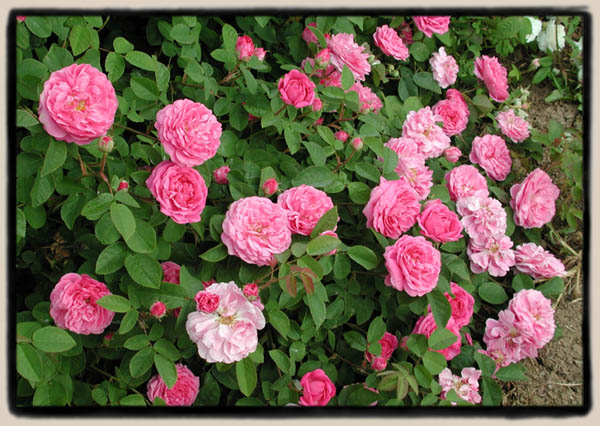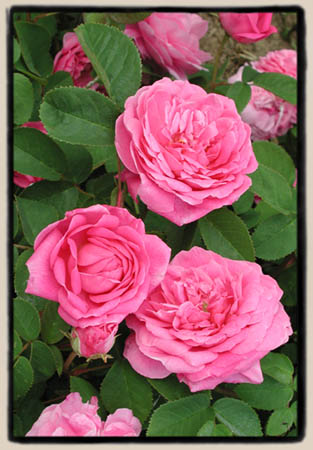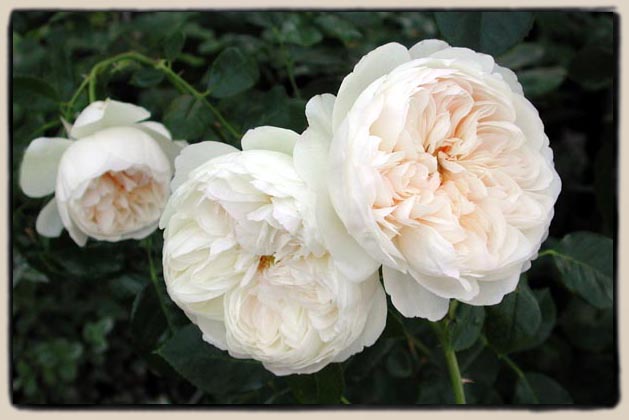 |
|
Albas |
Welcome to the March 2003 edition of my web site! The roses I write about are the Old Garden Roses and select shrub and miniature roses of the 20th century. For tips on rose culture, pruning, propagation and history, see the "Site Resources Guide" box in the navigation panel at left. To return to this page, click on the "thorn icon" in the margin at left. Articles from the previous months are archived and can be viewed by clicking on the listings in the left margin. Oh, and please don't write to me for a catalog or pricelist.....this is an information site only, not a commercial nursery. If you wish to buy roses, see my sponsor, The Uncommon Rose. Soil
Analysis: Just Do It! Getting your soil analyzed will likely be one of the best investments you ever make for your garden. Why? Armed with your soil’s exact composition, you will know—rather than having to guess—what you need to do in order to grow better roses, vegetables, flowers, plants, and trees.
Tracey explained the concept of "horizons". Soil is made up of three distinct layers called horizons "A", "B", and "C", and is topped with a layer variously known as "duff", "detritus", and "humus". The "C" horizon is the deepest, and is generally comprised of rocks and bedrock. It is the mineral component of the soil. The "B" horizon has smaller rocks and more weathered materials such as clays, the mineral calcite, and oxides. The "A" horizon is the upper and most weathered layer. It contains the highest level of organic debris of the three layers. Humus is decomposing organic matter. The area where it and the "A" horizon meet is called "topsoil", and is the richest, most fertile part of the soil. Since most plants root in the topsoil, the humus and the "A" horizon are where the gardener must concentrate the most amount of care. Unfortunately, many of our urban soils are stripped of topsoil and sometimes the entire "A" horizon is disturbed, leaving only a mixed "A" and "B" horizon.
In frustration I told her to go ahead and have my soil analyzed, but I wasn’t expecting to learn much. I mean, "everyone" knows that adding gypsum to "tight" soil will loosen it up. Tracey agreed, and while we waited for the labwork to come back she had me put down a lot of gypsum—eight pounds per 1,000 square feet—because she could tell by looking at it that my soil was bad off. When she got the results, even she was shocked by how awful Mira Mesa soil is. In fact, the lab—based in El Segundo, California—had never seen such results. Eight pounds of gypsum per 1,000 square feet? Try just under 170 pounds of gypsum per 1,000 square feet for six inches of depth! The pH was off, too, but it seemed that the very alkaline pH was about the least of my worries. The following are the values from some selected measurements. My comments are italicized; everything else is from the report itself. Ratio of calcium to magnesium needs to be more than 2 or 3
The proper ratio of calcium to magnesium is reversed in my soil (in other words, there should be at least two or three times as much calcium as there is magnesium, but my soil contains almost twice as much magnesium as calcium). This means that if I were to apply to my soil—which is already nearly toxic with magnesium—the popular "basal break booster" Epsom salts (magnesium sulfate), I would kill just about everything. Sodium should be less than potassium
Tracey’s hunch was right: the amount of salt in my soil is tremendous. Increasing problems start at 4 – 6 SAR
SAR is the Sodium Absorption Rate pH value
Estimated soil texture
Tracey had guessed that my soil was a type of loam, and had urged me to buy backfill with a similar composition to the native soil to lessen drainage problems that can arise when dissimilar layers meet. The silt loam that I purchased from Best Soils ended up being the right choice. Relative infiltration rate
This is the rate at which water filters through the soil. Estimated gypsum requirements-lbs./1000 sq. ft.
From these readings, Tracey was able to design an improvement plan tailor-made to my conditions. If I hadn’t have taken Tracey’s advise to go ahead with the soil analysis, I don’t think we would have been able to make a dent in the problems with my native soil…and my roses, vegetables, and fruit trees would have suffered or died as a result. Worse yet, I may have applied common additives—such as Epsom salts—that could have had disastrous consequences. I have heard reports from other homeowners in my complex that their bougainvilleas are dying, and that it can take as many as four times of laying sod before the grass will grow. Since I’m a board member of our homeowners association, I’m sharing what I have learned with whoever is interested in the hopes of solving some of our landscaping problems…now that I know what the problems are! Please: Do yourself—and your garden—a favor, and get your soil analyzed. All it takes is a handful of soil in a plastic baggy and a check for the work. The peace of mind and the knowledge you will get back will be more than worth it.
There
have been |
|




